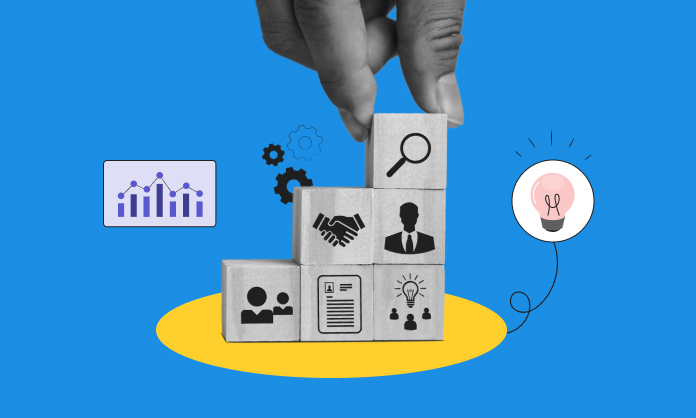The HR life cycle is an HR executive’s entire process, taking the business strategy through different execution phases. Here’s detailed information about how a company’s human resource cycle works.
It involves creating the HR strategy, working on organizational design, hiring and onboarding employees, and carrying out the procedures until the employee exits.
Keep reading.
Business Strategy
The first phase of the human resource cycle starts with the company’s business strategy. Usually, a business has several frameworks for defining its strategy. It includes the SWOT analysis method, Porter’s Five Forces Analysis, and the business model canvas, which are common and are frequently in use in the business landscape.
The business owners break down the business strategy into several strategic points. Next, the HR cycle takes place, and the business strategies translate into various HR goals and strategies.
HR Strategy
The next human resource cycle phase is defining the HR strategies. This is where the cycle embraces more HR-related tasks. The HR department, in this case, may also use the same tools used in business strategy to define the key areas of goals of the HR department.
However, knowing and understanding that HR strategies aren’t isolated from business ones is critical. Typically, the business strategies are translated into HR strategies. The HR strategies have to align with the business strategies.HR strategies are the successful execution of business goals.
Organizational Design
The next step in the human resource cycle is combining the organizational strategy and the HR strategy. The goal here is to design an organization that’s ready for success.
At the execution level, this is done in different ways. It may start with the most common way of taking the organizational goals, competitive strategies, and missions and defining organizational design based on them.
Organizational Design
The human resource cycles need to follow the business process and how human resources fit into the organization. After creating the organizational design, a company has to prepare job roles and team structures that will carry out the key results that fulfill the business goals.
At this stage, HR is responsible for creating jobs that attract talents who will carry out the business tasks, translating into the goals and results the business aims for. The jobs should also motivate the employees and be beneficial for their careers and well-being.
This human resource cycle involves several tasks like competency mapping, job analysis, and designing or redesigning job roles accordingly.
Following those steps, the HR department has to work on the team design. As defined in the organizational design, a good team design is essential and enables the business to carry out its objectives at the team level.
HR Planning
HR Planning requires forecasting the demands and supply of employees in the organization. It’s the organizational strategy that influences the demands. In addition, there are other factors like the investment in tech, and the labor composition and the quantity of labor needed also dominate the market for employees in the workplace.
Then, the supply part depends on the internal and external supply, retention techniques, and the personalities of the employees. The HR can take several other organizational actions based on supply and demand.
For example, they can later decide whether the company needs to actively recruit, continue internal movements, reskill, and automate several areas of the operations. It also determines whether the company can plan for early retirements or provide severance packages.
Company Culture & Vision
Building the work culture is also one of the crucial stages in the human resource cycle. In fact, it’s a critical step in the company’s long-term success. Company culture involves the understanding of what the company will become one day.
It involves the goals and objectives, as well as setting up the ways and practices that will help attain that goal one day. Cultural values shape the company in the long term.
Netflix has set an example about their company culture, which they explain as absolute values instead of nice-sounding values. These values also translate into the framework for communicating with employees who don’t adhere to the company’s culture and values.
Recruitment and Selection
The human resource cycle isn’t complete without the recruitment and selection of the right talents for the right jobs. They have to search for, interview, hire, and onboard talented individuals who’ll not only carry out the task to reach the business goal but also fit into the company culture.
Here, HR has to go through several common employment phases like employer branding, selection of candidates, assessment, and talent acquisition.
Onboarding
The employee onboarding process involves several HR responsibilities, like employee induction and employee orientation. The objective here is to get the new joiner completely involved with the company’s operations.
The onboarding process may require months, depending on the job role and if there is any employee training available to help the candidate speed up their work. In most workplaces, this human resource cycle takes about three to nine months.
Assessment & Appraisal
After onboarding and year-round work comes the performance management system. It’s also called the PMS in the corporate term.
This stage involves HR and the management marking the employee based on their performance and how that has contributed to the overall business goal. The management and the HR provide the employees with logical and reasonable feedback to improve their performance.
The PMS review involves reviewing the goals provided to the employee and how they have performed to attain them. Employees receive their feedback based on their performance, and they are marked based on the weightage each of the goals carries. If the goals aren’t met, the company develops improvement programs and helps the employees grow and mitigate skill gaps.
However, if they can meet the goals, then the employees get their reward based on the marking they receive for the PMS procedure.
Training & Development
The training and development phase of the human resource cycle also contributes immensely to the company’s objective. It’s the procedure to help the employees get the necessary skills to improve their current skills.
In some cases, if the employee is eligible for a promotion, the company provides training to prepare them for the position.
Engagement & Reward
Next, HR takes initiatives like the R&R to increase employee engagement. They create several workplace conditions aside from reward and recognition programs to build a positive state of mind for the employees.
They are the drivers of a work-related state of mind in employees, which keeps the employees engaged and provides a competitive advantage. In addition, they also introduce competitive compensation packages to keep the employees motivated. These are initiatives HR takes to retain high-performing employees.
Career Management
Career Management programs are also one of the key parts of the human resource cycle. The HR department creates the framework for employees to take their careers in a new direction.
It’s also one of the key responsibilities of HR in the workplace. For example, employees with the ambition to manage sales at some point must go through several commercial functions.
An HR manager creates a program and functions where the employees are motivated and passionate to follow their passion. This also helps HR create a high-performing work culture.
Exit
The human resource cycle ends with the exit of an employee. This phase marks the endpoint of an employee’s involvement with an organization.
The best case scenario for a company is to leave a good impression about the company. They can also turn into promoters of the company, helping HR recruit new candidates for the role.
Final words
The human resource cycle is very dynamic and is a continuous process; it changes at different levels and starts with the business objective. Both the business objective and employee exit have a direct impact on the human resource cycle and, therefore, on the business itself.
The business strategy is built on the analysis and strength of the business, which is closely related to the workforce and core competencies. The human resource managers are responsible for managing the entire cycle, which has a direct impact on the business.
For More Small Business Related Information Click Below!!




Leave A Comment